Hongyi Wang
Token Level Routing Inference System for Edge Devices
Apr 10, 2025Abstract:The computational complexity of large language model (LLM) inference significantly constrains their deployment efficiency on edge devices. In contrast, small language models offer faster decoding and lower resource consumption but often suffer from degraded response quality and heightened susceptibility to hallucinations. To address this trade-off, collaborative decoding, in which a large model assists in generating critical tokens, has emerged as a promising solution. This paradigm leverages the strengths of both model types by enabling high-quality inference through selective intervention of the large model, while maintaining the speed and efficiency of the smaller model. In this work, we present a novel collaborative decoding inference system that allows small models to perform on-device inference while selectively consulting a cloud-based large model for critical token generation. Remarkably, the system achieves a 60% performance gain on CommonsenseQA using only a 0.5B model on an M1 MacBook, with under 7% of tokens generation uploaded to the large model in the cloud.
CITER: Collaborative Inference for Efficient Large Language Model Decoding with Token-Level Routing
Feb 04, 2025Abstract:Large language models have achieved remarkable success in various tasks but suffer from high computational costs during inference, limiting their deployment in resource-constrained applications. To address this issue, we propose a novel CITER (\textbf{C}ollaborative \textbf{I}nference with \textbf{T}oken-l\textbf{E}vel \textbf{R}outing) framework that enables efficient collaboration between small and large language models (SLMs & LLMs) through a token-level routing strategy. Specifically, CITER routes non-critical tokens to an SLM for efficiency and routes critical tokens to an LLM for generalization quality. We formulate router training as a policy optimization, where the router receives rewards based on both the quality of predictions and the inference costs of generation. This allows the router to learn to predict token-level routing scores and make routing decisions based on both the current token and the future impact of its decisions. To further accelerate the reward evaluation process, we introduce a shortcut which significantly reduces the costs of the reward estimation and improving the practicality of our approach. Extensive experiments on five benchmark datasets demonstrate that CITER reduces the inference costs while preserving high-quality generation, offering a promising solution for real-time and resource-constrained applications.
LLM360 K2: Building a 65B 360-Open-Source Large Language Model from Scratch
Jan 16, 2025Abstract:We detail the training of the LLM360 K2-65B model, scaling up our 360-degree OPEN SOURCE approach to the largest and most powerful models under project LLM360. While open-source LLMs continue to advance, the answer to "How are the largest LLMs trained?" remains unclear within the community. The implementation details for such high-capacity models are often protected due to business considerations associated with their high cost. This lack of transparency prevents LLM researchers from leveraging valuable insights from prior experience, e.g., "What are the best practices for addressing loss spikes?" The LLM360 K2 project addresses this gap by providing full transparency and access to resources accumulated during the training of LLMs at the largest scale. This report highlights key elements of the K2 project, including our first model, K2 DIAMOND, a 65 billion-parameter LLM that surpasses LLaMA-65B and rivals LLaMA2-70B, while requiring fewer FLOPs and tokens. We detail the implementation steps and present a longitudinal analysis of K2 DIAMOND's capabilities throughout its training process. We also outline ongoing projects such as TXT360, setting the stage for future models in the series. By offering previously unavailable resources, the K2 project also resonates with the 360-degree OPEN SOURCE principles of transparency, reproducibility, and accessibility, which we believe are vital in the era of resource-intensive AI research.
Crystal: Illuminating LLM Abilities on Language and Code
Nov 06, 2024
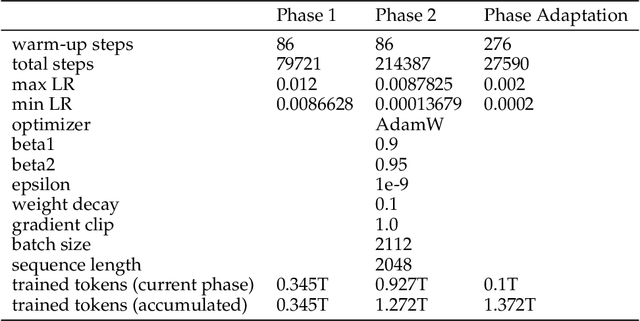
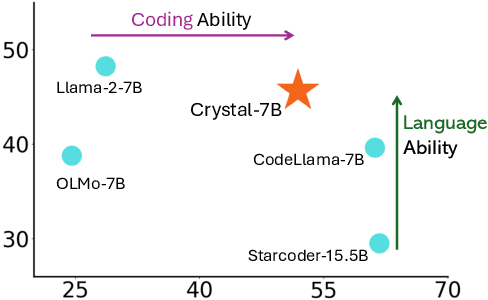
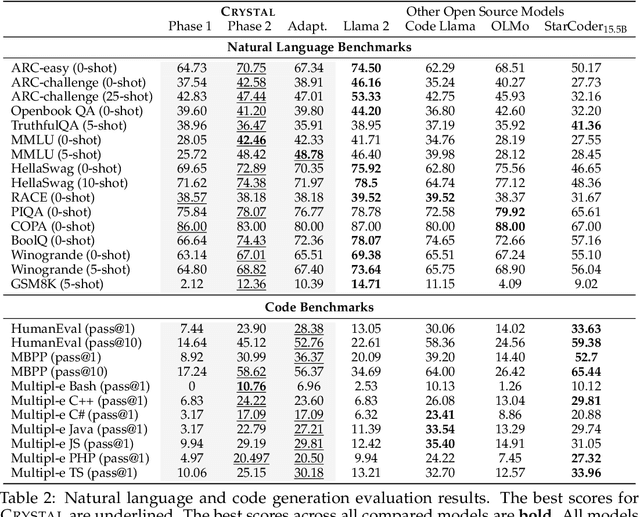
Abstract:Large Language Models (LLMs) specializing in code generation (which are also often referred to as code LLMs), e.g., StarCoder and Code Llama, play increasingly critical roles in various software development scenarios. It is also crucial for code LLMs to possess both code generation and natural language abilities for many specific applications, such as code snippet retrieval using natural language or code explanations. The intricate interaction between acquiring language and coding skills complicates the development of strong code LLMs. Furthermore, there is a lack of thorough prior studies on the LLM pretraining strategy that mixes code and natural language. In this work, we propose a pretraining strategy to enhance the integration of natural language and coding capabilities within a single LLM. Specifically, it includes two phases of training with appropriately adjusted code/language ratios. The resulting model, Crystal, demonstrates remarkable capabilities in both domains. Specifically, it has natural language and coding performance comparable to that of Llama 2 and Code Llama, respectively. Crystal exhibits better data efficiency, using 1.4 trillion tokens compared to the more than 2 trillion tokens used by Llama 2 and Code Llama. We verify our pretraining strategy by analyzing the training process and observe consistent improvements in most benchmarks. We also adopted a typical application adaptation phase with a code-centric data mixture, only to find that it did not lead to enhanced performance or training efficiency, underlining the importance of a carefully designed data recipe. To foster research within the community, we commit to open-sourcing every detail of the pretraining, including our training datasets, code, loggings and 136 checkpoints throughout the training.
SemSim: Revisiting Weak-to-Strong Consistency from a Semantic Similarity Perspective for Semi-supervised Medical Image Segmentation
Oct 17, 2024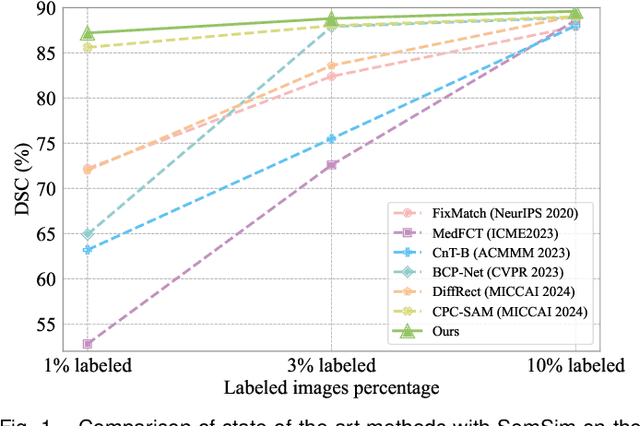
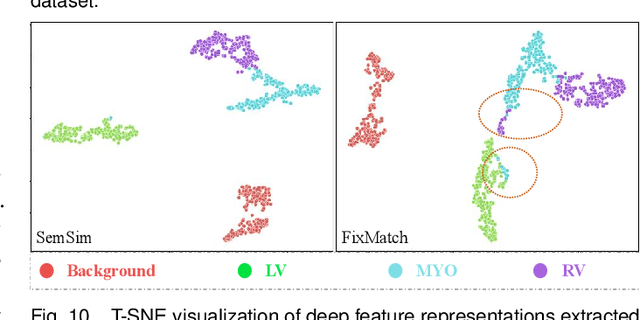

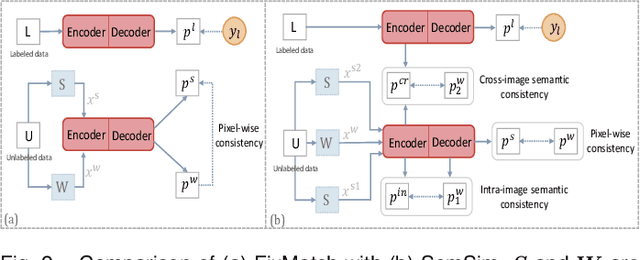
Abstract:Semi-supervised learning (SSL) for medical image segmentation is a challenging yet highly practical task, which reduces reliance on large-scale labeled dataset by leveraging unlabeled samples. Among SSL techniques, the weak-to-strong consistency framework, popularized by FixMatch, has emerged as a state-of-the-art method in classification tasks. Notably, such a simple pipeline has also shown competitive performance in medical image segmentation. However, two key limitations still persist, impeding its efficient adaptation: (1) the neglect of contextual dependencies results in inconsistent predictions for similar semantic features, leading to incomplete object segmentation; (2) the lack of exploitation of semantic similarity between labeled and unlabeled data induces considerable class-distribution discrepancy. To address these limitations, we propose a novel semi-supervised framework based on FixMatch, named SemSim, powered by two appealing designs from semantic similarity perspective: (1) rectifying pixel-wise prediction by reasoning about the intra-image pair-wise affinity map, thus integrating contextual dependencies explicitly into the final prediction; (2) bridging labeled and unlabeled data via a feature querying mechanism for compact class representation learning, which fully considers cross-image anatomical similarities. As the reliable semantic similarity extraction depends on robust features, we further introduce an effective spatial-aware fusion module (SFM) to explore distinctive information from multiple scales. Extensive experiments show that SemSim yields consistent improvements over the state-of-the-art methods across three public segmentation benchmarks.
Model-GLUE: Democratized LLM Scaling for A Large Model Zoo in the Wild
Oct 07, 2024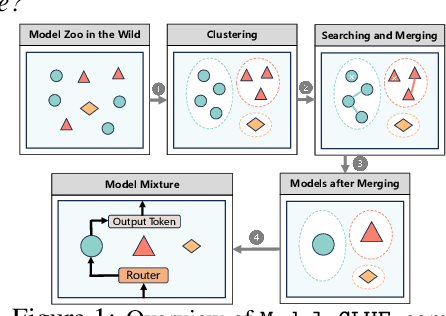
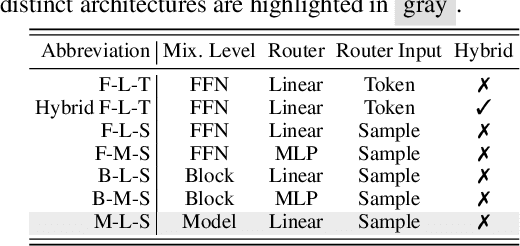
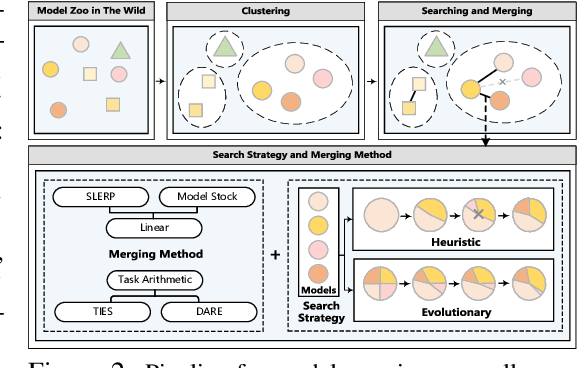
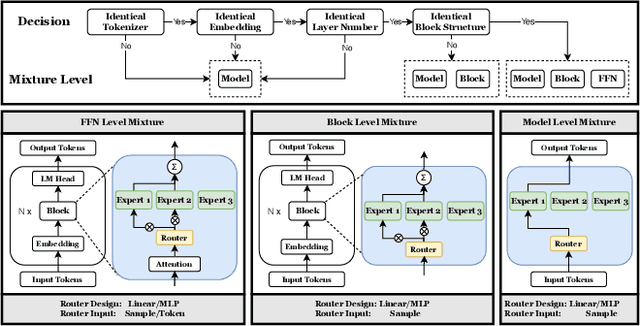
Abstract:As Large Language Models (LLMs) excel across tasks and specialized domains, scaling LLMs based on existing models has garnered significant attention, which faces the challenge of decreasing performance when combining disparate models. Various techniques have been proposed for the aggregation of pre-trained LLMs, including model merging, Mixture-of-Experts, and stacking. Despite their merits, a comprehensive comparison and synergistic application of them to a diverse model zoo is yet to be adequately addressed. In light of this research gap, this paper introduces Model-GLUE, a holistic LLM scaling guideline. First, our work starts with a benchmarking of existing LLM scaling techniques, especially selective merging, and variants of mixture. Utilizing the insights from the benchmark results, we formulate an strategy for the selection and aggregation of a heterogeneous model zoo characterizing different architectures and initialization. Our methodology involves the clustering of mergeable models and optimal merging strategy selection, and the integration of clusters through a model mixture. Finally, evidenced by our experiments on a diverse Llama-2-based model zoo, Model-GLUE shows an average performance enhancement of 5.61%, achieved without additional training. Codes are available at: https://github.com/Model-GLUE/Model-GLUE.
FLoRA: Federated Fine-Tuning Large Language Models with Heterogeneous Low-Rank Adaptations
Sep 09, 2024Abstract:The rapid development of Large Language Models (LLMs) has been pivotal in advancing AI, with pre-trained LLMs being adaptable to diverse downstream tasks through fine-tuning. Federated learning (FL) further enhances fine-tuning in a privacy-aware manner by utilizing clients' local data through in-situ computation, eliminating the need for data movement. However, fine-tuning LLMs, given their massive scale of parameters, poses challenges for clients with constrained and heterogeneous resources in FL. Previous methods employed low-rank adaptation (LoRA) for efficient federated fine-tuning but utilized traditional FL aggregation strategies on LoRA adapters. These approaches led to mathematically inaccurate aggregation noise, reducing fine-tuning effectiveness and failing to address heterogeneous LoRAs. In this work, we first highlight the mathematical incorrectness of LoRA aggregation in existing federated fine-tuning methods. We introduce a new approach called FLORA that enables federated fine-tuning on heterogeneous LoRA adapters across clients through a novel stacking-based aggregation method. Our approach is noise-free and seamlessly supports heterogeneous LoRA adapters. Extensive experiments demonstrate FLORA' s superior performance in both homogeneous and heterogeneous settings, surpassing state-of-the-art methods. We envision this work as a milestone for efficient, privacy-preserving, and accurate federated fine-tuning of LLMs. Our code is available at https://github.com/ATP-1010/FederatedLLM.
HSVLT: Hierarchical Scale-Aware Vision-Language Transformer for Multi-Label Image Classification
Jul 23, 2024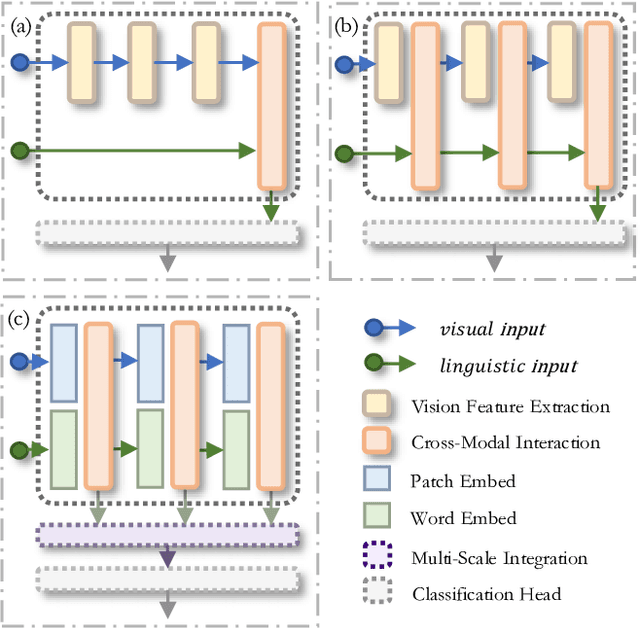


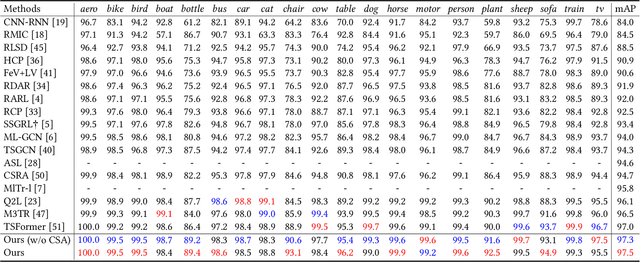
Abstract:The task of multi-label image classification involves recognizing multiple objects within a single image. Considering both valuable semantic information contained in the labels and essential visual features presented in the image, tight visual-linguistic interactions play a vital role in improving classification performance. Moreover, given the potential variance in object size and appearance within a single image, attention to features of different scales can help to discover possible objects in the image. Recently, Transformer-based methods have achieved great success in multi-label image classification by leveraging the advantage of modeling long-range dependencies, but they have several limitations. Firstly, existing methods treat visual feature extraction and cross-modal fusion as separate steps, resulting in insufficient visual-linguistic alignment in the joint semantic space. Additionally, they only extract visual features and perform cross-modal fusion at a single scale, neglecting objects with different characteristics. To address these issues, we propose a Hierarchical Scale-Aware Vision-Language Transformer (HSVLT) with two appealing designs: (1)~A hierarchical multi-scale architecture that involves a Cross-Scale Aggregation module, which leverages joint multi-modal features extracted from multiple scales to recognize objects of varying sizes and appearances in images. (2)~Interactive Visual-Linguistic Attention, a novel attention mechanism module that tightly integrates cross-modal interaction, enabling the joint updating of visual, linguistic and multi-modal features. We have evaluated our method on three benchmark datasets. The experimental results demonstrate that HSVLT surpasses state-of-the-art methods with lower computational cost.
* 10 pages, 6 figures
Crystals with Transformers on Graphs, for Prediction of Unconventional Crystal Material Properties and the Benchmark
Jul 23, 2024Abstract:The ionic bonding across the lattice and ordered microscopic structures endow crystals with unique symmetry and determine their macroscopic properties. Unconventional crystals, in particular, exhibit non-traditional lattice structures or possess exotic physical properties, making them intriguing subjects for investigation. Therefore, to accurately predict the physical and chemical properties of crystals, it is crucial to consider long-range orders. While GNN excels at capturing the local environment of atoms in crystals, they often face challenges in effectively capturing longer-ranged interactions due to their limited depth. In this paper, we propose CrysToGraph ($\textbf{Crys}$tals with $\textbf{T}$ransformers $\textbf{o}$n $\textbf{Graph}$s), a novel transformer-based geometric graph network designed specifically for unconventional crystalline systems, and UnconvBench, a comprehensive benchmark to evaluate models' predictive performance on unconventional crystal materials such as defected crystals, low-dimension crystals and MOF. CrysToGraph effectively captures short-range interactions with transformer-based graph convolution blocks as well as long-range interactions with graph-wise transformer blocks. CrysToGraph proofs its effectiveness in modelling unconventional crystal materials in multiple tasks, and moreover, it outperforms most existing methods, achieving new state-of-the-art results on the benchmarks of both unconventional crystals and traditional crystals.
ViT-1.58b: Mobile Vision Transformers in the 1-bit Era
Jun 26, 2024Abstract:Vision Transformers (ViTs) have achieved remarkable performance in various image classification tasks by leveraging the attention mechanism to process image patches as tokens. However, the high computational and memory demands of ViTs pose significant challenges for deployment in resource-constrained environments. This paper introduces ViT-1.58b, a novel 1.58-bit quantized ViT model designed to drastically reduce memory and computational overhead while preserving competitive performance. ViT-1.58b employs ternary quantization, which refines the balance between efficiency and accuracy by constraining weights to {-1, 0, 1} and quantizing activations to 8-bit precision. Our approach ensures efficient scaling in terms of both memory and computation. Experiments on CIFAR-10 and ImageNet-1k demonstrate that ViT-1.58b maintains comparable accuracy to full-precision Vit, with significant reductions in memory usage and computational costs. This paper highlights the potential of extreme quantization techniques in developing sustainable AI solutions and contributes to the broader discourse on efficient model deployment in practical applications. Our code and weights are available at https://github.com/DLYuanGod/ViT-1.58b.
 Add to Chrome
Add to Chrome Add to Firefox
Add to Firefox Add to Edge
Add to Edge